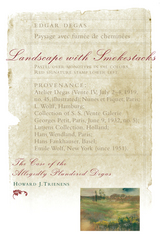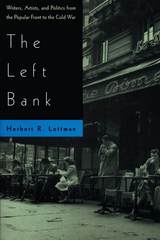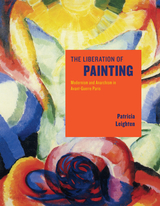108 books about Paris and 4
start with L
108 books about Paris and 4
108 books about Paris
4 start with L start with L
4 start with L start with L

Landscape with Smokestacks
The Case of the Allegedly Plundered Degas
Howard J. Treinens
Northwestern University Press, 2000
The dispute over Edgar Degas’s Landscape with Smokestacks was featured in newspapers and on television. But because the suit was settled before trial, the story behind the headlines was never publicly presented. Howard J. Trienens, a lawyer for the defendant collector, traces the landscape’s travels from its prewar home to its current location in the Art Institute of Chicago, laying out the mystery surrounding the work and demonstrating the legal complexities that plague Holocaust restitution cases, yet are seldom examined in depth by the media.
[more]

Le Corbusier
The City of Refuge, Paris 1929/33
Brian Brace Taylor
University of Chicago Press, 1988
The City of Refuge complex—commissioned by the Salvation Army as part of its program to transform social outcasts into spiritually renewed workers—represents a significant confluence of design principles, technological experiments, and attitudes on reform. It also provides rare insights into the work of one of the twentieth century's greatest architects, Le Corbusier.
Brian Brace Taylor draws on extensive archival research to reconstruct each step of the architect's attraction to the commission, his design process and technological innovations, the social and philosophical compatibility of the Salvation Army with Le Corbusier's own ideas for urban planning, and finally, the many modifications required, first to eliminate defects and later to accommodate changes in the services the building provided. Throughout, Taylor focuses on Le Corbusier's environmental, technological, and social intentions as opposed to his strictly formal intentions. He shows that the City of Refuge became primarily a laboratory for the architect's own research and not simply a conventional solution to residents' requirements or the Salvation Army's program.
Brian Brace Taylor draws on extensive archival research to reconstruct each step of the architect's attraction to the commission, his design process and technological innovations, the social and philosophical compatibility of the Salvation Army with Le Corbusier's own ideas for urban planning, and finally, the many modifications required, first to eliminate defects and later to accommodate changes in the services the building provided. Throughout, Taylor focuses on Le Corbusier's environmental, technological, and social intentions as opposed to his strictly formal intentions. He shows that the City of Refuge became primarily a laboratory for the architect's own research and not simply a conventional solution to residents' requirements or the Salvation Army's program.
[more]

The Left Bank
Writers, Artists, and Politics from the Popular Front to the Cold War
Herbert Lottman
University of Chicago Press, 1998
This story begins in the Paris of the 1930s, when artists and writers stood at the center of the world stage. In the decade that saw the rise of the Nazis, much of the thinking world sought guidance from this extraordinary group of intellectuals. Herbert Lottman's chronicle follows the influential players—Gide, Malraux, Sartre, de Beauvoir, Koestler, Camus, and their pro-Fascist counterparts—through the German occupation, Liberation, and into the Cold War, when the struggle between superpowers all but drowned out their voices.
"Surprisingly fresh and intense. . . . A retrospective travelogue of the Left Bank in the days when it was the setting for almost all French intellectual activity. . . . Absorbing."—Naomi Bliven, New Yorker
"As an introduction to a period in French history already legendary, The Left Bank is superb."—Michael Dirda, Washington Post Book World
"An intellectual history. A history of the interaction between politics and letters. And a rumination on the limitless credulity of intellectuals."—Christopher Hitchens, New Statesman
"Surprisingly fresh and intense. . . . A retrospective travelogue of the Left Bank in the days when it was the setting for almost all French intellectual activity. . . . Absorbing."—Naomi Bliven, New Yorker
"As an introduction to a period in French history already legendary, The Left Bank is superb."—Michael Dirda, Washington Post Book World
"An intellectual history. A history of the interaction between politics and letters. And a rumination on the limitless credulity of intellectuals."—Christopher Hitchens, New Statesman
[more]

The Liberation of Painting
Modernism and Anarchism in Avant-Guerre Paris
Patricia Leighten
University of Chicago Press, 2013
The years before World War I were a time of social and political ferment in Europe, which profoundly affected the art world. A major center of this creative tumult was Paris, where many avant-garde artists sought to transform modern art through their engagement with radical politics. In this provocative study of art and anarchism in prewar France, Patricia Leighten argues that anarchist aesthetics and a related politics of form played crucial roles in the development of modern art, only to be suppressed by war fever and then forgotten.
Leighten examines the circle of artists—Pablo Picasso, Juan Gris, František Kupka, Maurice de Vlaminck, Kees Van Dongen, and others—for whom anarchist politics drove the idea of avant-garde art, exploring how their aesthetic choices negotiated the myriad artistic languages operating in the decade before World War I. Whether they worked on large-scale salon paintings, political cartoons, or avant-garde abstractions, these artists, she shows, were preoccupied with social criticism. Each sought an appropriate subject, medium, style, and audience based on different conceptions of how art influences society—and their choices constantly shifted as they responded to the dilemmas posed by contradictory anarchist ideas. According to anarchist theorists, art should expose the follies and iniquities of the present to the masses, but it should also be the untrammeled expression of the emancipated individual and open a path to a new social order. Revealing how these ideas generated some of modernism’s most telling contradictions among the prewar Parisian avant-garde, The Liberation of Painting restores revolutionary activism to the broader history of modern art.
[more]
READERS
Browse our collection.
PUBLISHERS
See BiblioVault's publisher services.
STUDENT SERVICES
Files for college accessibility offices.
UChicago Accessibility Resources
home | accessibility | search | about | contact us
BiblioVault ® 2001 - 2025
The University of Chicago Press









